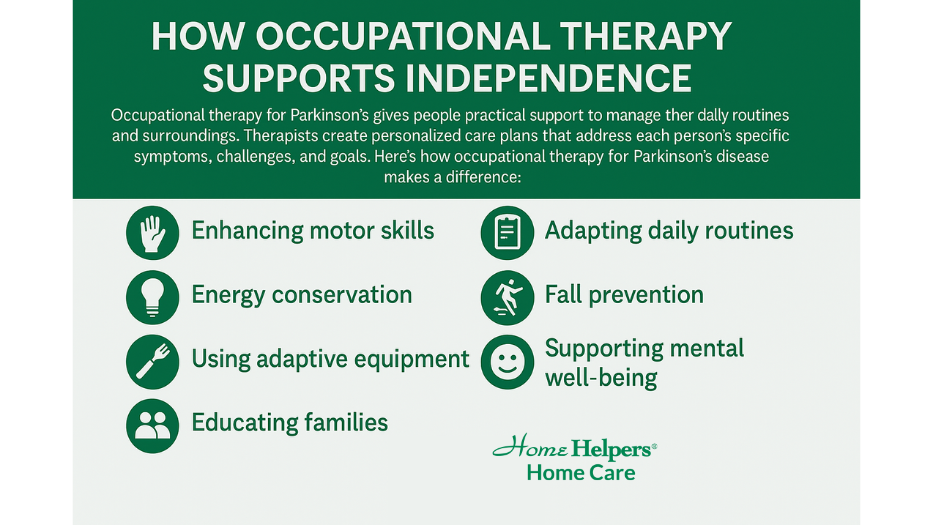The Role of Occupational Therapy in Parkinson's Disease

Author: Home Helpers Home Care
Parkinson's disease is a brain disorder that gets worse over time. It affects a person’s movement, thinking, and ability to do daily tasks. Over time, symptoms like tremors, stiffness, and fatigue make it harder for individuals to remain independent. While medications can help manage symptoms, they don't address the challenges of daily living. This is where occupational therapy for Parkinson’s disease becomes an essential part of care.
While medications can help manage symptoms, they don't address the challenges of daily living. This is where occupational therapy for Parkinson’s disease becomes an essential part of care.
Occupational therapy for Parkinson’s disease empowers individuals to remain as independent and active as possible. It helps people adjust their routines and make changes to their surroundings. It also teaches them skills to do daily tasks safely and confidently.
A helpful resource explains how occupational therapy supports people with Parkinson’s. It helps them improve their daily routines and quality of life.
What Is Occupational Therapy?
Occupational therapy is a type of care that helps people do everyday activities more easily and safely. Examples include activities such as dressing, preparing meals, writing, or bathing.
An occupational therapist helps each person figure out which tasks are difficult. Then, they show easier ways to do those tasks or suggest helpful tools.
How Parkinson’s Affects Everyday Life
Parkinson’s impacts nearly every aspect of daily living, especially tasks that require movement, focus, or coordination. Something as simple as brushing teeth or preparing a meal can become difficult. Common challenges include:
- Tremors and stiffness, make it hard to grip objects or move smoothly.
- Slowed movements (bradykinesia) affect routine tasks like getting dressed or writing.
- Fatigue and reduced endurance make it difficult to complete even small chores.
- Balance issues, lead to an increased risk of falls.
- Cognitive changes, such as memory loss or trouble planning.
These cognitive impairments can make it harder to manage daily schedules or follow multi-step tasks without assistance. These difficulties can lead to a loss of independence, frustration, and emotional distress. Without the right support, individuals may become more reliant on caregivers for everyday needs. This highlights the importance of Parkinson’s disease therapy options that focus on daily function and quality of life.
Parkinson’s disease often makes daily routines more difficult. Occupational therapy offers personalized support to help patients manage symptoms and continue living as independently as possible.
How Occupational Therapy Supports Independence

Occupational therapy for Parkinson’s gives people practical support to manage their daily routines and surroundings. Therapists create personalized care plans that address each person’s specific symptoms, challenges, and goals. Here's how occupational therapy for Parkinson’s disease makes a difference:
1. Enhancing motor skills:
Therapists guide seniors through hand exercises to improve fine motor control. These exercises help them use utensils, pens, buttons, and phones with more ease. For example, therapists may teach someone with tremors how to strengthen their hands and use tools like button hooks to make dressing easier. Therapies that help with Parkinson’s disease help people move better and do daily tasks more easily.
2. Adapting daily routines:
OT breaks complex tasks into simpler steps, helping people manage grooming, bathing, cooking, and more at their own pace. For example, a therapist may show someone how to set out their clothes the night before or use a shower chair to save energy. They may also use a checklist when cooking to help them stay focused. This structured support for Parkinson’s and daily living activities improves confidence and reduces the chances of frustration.
3. Energy conservation:
Therapists teach how to organize the day with rest periods and prioritize important tasks to avoid fatigue. A person might learn to complete the most demanding chores, like laundry or meal prep, earlier in the day when energy levels are higher. Breaking tasks into short intervals and alternating activities with rest can significantly reduce strain.
4. Fall prevention:
By recommending changes at home—like removing tripping hazards or installing grab bars—occupational therapists reduce fall risk. For example, a therapist may move furniture to create clear walking paths and add lights in dark hallways. They may also suggest using slip-resistant rugs for safety. This is a key part of Parkinson’s disease and home modifications, ensuring safety and independence.
5. Using adaptive equipment:
Therapists provide assistive devices for Parkinson’s patients, such as weighted utensils and dressing aids. These tools help make daily tasks safer and easier. People with hand tremors may find that using a weighted spoon helps them eat without spilling, giving them more comfort and independence at mealtime.
6. Supporting mental well-being:
Occupational therapy also includes memory exercises, relaxation strategies, and support for anxiety or frustration. For example, a therapist may teach mindfulness, breathing exercises, or journaling to help manage stress. These tools can support how to improve the quality of life with Parkinson’s disease. journaling to help manage emotional stress, contributing to how to improve quality of life with Parkinson’s disease.
In addition to occupational therapy, many individuals also benefit from speech therapy, which addresses changes in vocal strength and clarity that often accompany Parkinson’s.
7. Educating families:
Therapists help family caregivers learn how to support their loved one and create a safe home that encourages independence. They may teach caregivers how to help without doing everything for their loved ones. This approach helps the person stay independent while receiving support and encouragement.
What does an occupational therapist do for Parkinson’s patients? They provide tools, strategies, and personalized guidance to improve quality of life, foster independence, and maintain safety at home.
Understanding how occupational therapy helps Parkinson’s patients is vital. Occupational therapists provide targeted therapies and support strategies to help people manage daily tasks with more control. This guidance helps improve their skills, build independence, and boost their confidence.
When and Why to Start Occupational Therapy
Occupational therapy can be beneficial at any stage of Parkinson’s disease. In the early stages, it can help individuals adapt their routines before symptoms become more severe, building habits that support long-term independence.
Early intervention helps individuals prepare for future challenges and maintain their routines as long as possible. Even in later stages, OT can help manage complex needs and prevent further loss of function.
Signs that it might be time to start include:
- Struggling with grooming, bathing, or cooking
- Increased risk of falling
- Changes in writing, speech, or hand coordination
- Feeling anxious or overwhelmed by daily routines
By focusing on what matters most to the individual, occupational therapy for Parkinson’s disease helps people live with more confidence, safety, and independence. This support is essential in managing Parkinson’s disease and preserving dignity.
Additionally, occupational therapy plays a key role in helping to improve the quality of life with Parkinson’s disease. By reducing frustration, encouraging engagement in meaningful activities, and promoting self-reliance, OT can have a powerful impact on emotional and physical well-being.
Final Thoughts
Occupational therapy for Parkinson’s disease is more than just rehabilitation. It’s a personalized, holistic approach that plays an important role in Parkinson’s disease treatment by helping individuals preserve their independence, dignity, and quality of life.
The benefits of occupational therapy for Parkinson’s disease go beyond physical movement. It helps improve motor skills, supports daily routines, reduces the risk of falls, and strengthens emotional well-being. It also gives families the knowledge they need to support their loved one’s care.
Joining a support group can further help caregivers and individuals with Parkinson’s share resources, learn from others, and find emotional encouragement.
If you or someone you love is facing challenges from Parkinson’s disease, talk to a healthcare provider about adding occupational therapy for Parkinson’s to the care plan. With the right support, daily tasks can become easier, and individuals can stay more independent at home.
And if you need a trusted caregiver, Home Helpers Home Care of Bradenton is always here to help — providing compassionate in-home care tailored to your needs.
